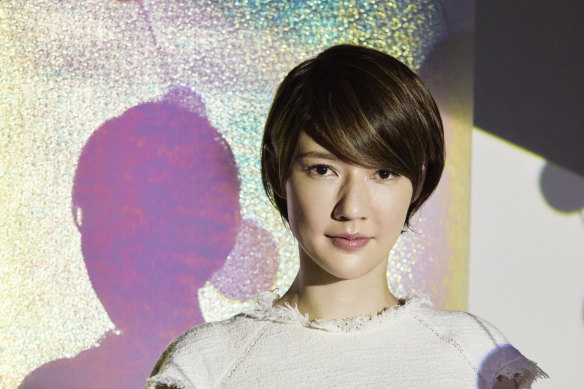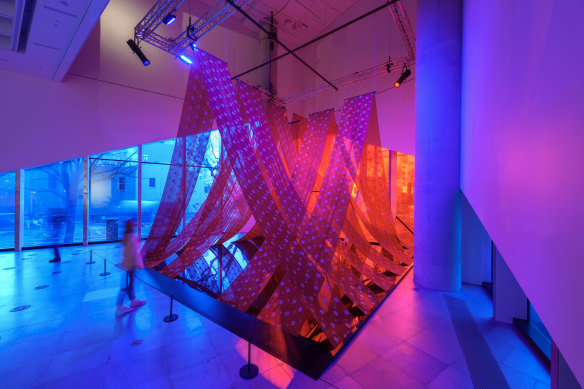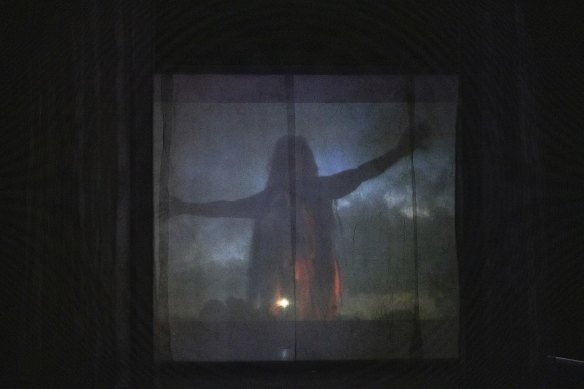Does science fiction have its roots in Asian mythology?
Who invented science fiction? Everyone from Mary Shelley to Isaac Asimov and 17th-century German author Johann Valentin Andreae has been credited, but a new exhibition at Science Gallery at the University of Melbourne posits a very different idea – that many of Western science fiction’s best known tropes actually have their roots in ancient Asian mythologies.
The gallery’s new exhibition SCI-FI: Mythologies Transformed, first exhibited at the ArtScience Museum in Singapore, features works from mostly women artists from the Asia-Pacific region, and for the Australian iteration, from First Nations women artists.

Galactica v-2.1 Dharma Garden by Indonesian art collective The House of Natural Fiber, which explores the idea of terraforming.Credit: Matthew Stanton
During the pandemic, Honor Harger, ArtScience Museum director and one of the exhibition’s co-curators, found herself thinking about a more harmonious future. She’d also noticed a wave of contemporary Asian women artists making works with science-fiction aesthetics. “And these works had a completely different feeling than other types of sci-fi that we’re familiar with, which is usually made by men,” she says.
Much science fiction, Harger says, veers on the dystopian, and that wasn’t the vibe she was seeing in the work made by women artists. “Their work was coming from a much more thoughtful … not utopian perspective, but what people often refer to as ‘protopian’ place – visions of the future that are neither negative or positive, but perhaps a continuance of a more harmonious now.”
The idea that many Western paradigms of science fiction might actually have their roots in Asian philosophy and spirituality is, says Harger, a somewhat contentious claim. “But it’s certainly evident in some of the artists’ work,” she says, citing the film installation by South Korean artist duo Moon Kyungwon and Jeon Joonho, The Ways of Folding Space and Flying, which fuses elements of modern technology and ancient transcendental practices.
“The idea of folding space sounds like it’s from Frank Herbert’s Dune, and flying is a key idea within most space-related sci-fi, but that title comes directly from Taoism,” Harger explains. “The name of the work in Korean is a literal lift from the Taoist practice of drawing on your spiritual beliefs to enact a ... fold in space and flying through space and time.”

A still from the multi-channel installation The Ways of Folding Space & Flying by the Korean duo Moon Kyungwon and Jeon Joonho.
Harger says it’s theorised that early science fiction writers probably encountered such ideas, whether through other forms of literature or through being familiar with Asian belief systems. “It can’t be a coincidence,” she says. “The artists [for the exhibition] were leading us to this premise, either directly or aesthetically through work of people like Mariko Mori.” Mori’s video work Miko No Inori presents the artist as a shaman or otherworldly figure performing some kind of ritual and beckoning the viewer to travel between worlds.
Other works in the exhibition explore parallel universes, artificial intelligence and interdimensional travel. The largest, and perhaps most striking, comes from Sputniko!, a Japanese multimedia artist, designer and singer, whose work has long straddled technology and art. An associate professor at the Tokyo University of Arts, Sputniko! (real name Hiromi Ozaki) has also taught at the MIT Media Lab and has work in many permanent collections around the world, including the V&A in London and Hong Kong’s M+ Museum.
Her large-scale installation The Red Silk of Fate is inspired by the legend in many Asian cultures that a red silk line connects two people who are destined to be together. Sputniko! has created a “shrine” made from red silk – but not just any silk. Working with a professor from the University of Tokyo, the silk used for the work’s panels that comes from genetically engineered silkworms containing oxytocin, the “socially bonding love hormone”.
The work is also accompanied by a video created by and starring Sputniko!. Red Silk of Fate – Tamaki’s Crush is the story of a scientist who modifies silkworms to produce silk that will make her crush fall in love with her, and the song accompanying the video is written and sung by Sputniko!
“The works were inspired by the mythological concept of the red thread connecting destined lovers, found in Chinese, Japanese, and Korean cultures,” Ozaki says. “The delicate red thread symbolises both the fragility and passion of love.”

Japanese multimedia artist, designer and singer-songwriter Sputniko!Credit: Mami Arai
After reading research papers on bioengineering, she discovered the work of Professor Hideki Sezutsu, who had genetically engineered silkworms to produce silk that glowed red and green using the genes of glowing jellyfish and coral. (The work is beautiful as it is, but when viewed through special yellow glasses supplied next to the installation, flowers embroidered on the panels glow.)
“Collaborating with Sezutsu, we genetically engineered silkworms to produce red silk containing oxytocin, and the installation features embroidered silk fabric created with this genetically engineered silk,” she says. “I want to invite contemplation of love and bonding through the work, and imagine future biotechnologies creating living things that we thought only existed in mythologies.”
In just a few months those silkworms, which Ozaki says are still producing silk in the lab, produced an entirely new living organism that had previously only existed in Asian mythology.

Sputniko!’s installation The Red Silk of Fate at Science Gallery Melbourne.Credit: Matthew Stanton
Ozaki’s other works include Sushiborg Yukari, a cyborg designed to serve sushi on a rotating belt, which satirises the Japanese practice of serving sushi on naked women, and Menstruation Machine, a wearable machine designed to simulate the pain and bleeding of a five-day menstruation process.
“My practice bridges technology and art because I’ve always been fascinated by how technological advancements shape our society and influence our daily lives,” she says. “I aim to create thought-provoking works that challenge conventional perspectives and spark discussions about the future.”
Many of the show’s works also flip myths when it comes to women, such as Namahage in Tokyo by Etsuko Ichihara, which re-frames Namahage, a demon in Japanese folklore who traditionally threatens lazy children. In Ichihara’s reimagining, in a video installation (the costume she created for the video is also on display), Namahage becomes a futuristic creature who hunts down and punishes adults who have been making derogatory comments about women online by hacking into their minds.
Wemba-Wemba and Gunditjmara artist Paola Balla’s film installation work Mok Mok Murrup Yakuwa does the same with a First Nations legend.

A still from Paola Balla’s work Mok Mok Murrup Yakuwa.Credit: Penny Stephens
First commissioned for the Rising festival’s 2023 Shadow Spirit exhibition, the piece transforms the Wemba-Wemba character Mok Mok (pronounced “mook mook”) from a terrifying old hag who would sing babies and children away into a sovereign goddess and guardian figure.
“Ghost stories and spiritual entities are a big part of blackfella life, and Mok Mok was very much a part of my childhood,” Balla says. “But I wasn’t afraid of her, even though she was scary. I was more fascinated with her because she was a female entity that men were afraid of. She was told to me as a female entity that could punish men who broke the law.”
In Balla’s film, which plays inside a tent-like structure made from fabric dyed using bush ingredients, Mok Mok is played by her mum as a ghostly figure who isn’t scary, but instead elevated into a “fierce and fearless Black feminist” figure.
“The thing that fascinated me was that it was her independence that made her fearsome,” says Balla, “and I wanted to play with that idea, and bring her into the present.”
The entire exhibition, says Melbourne co-curator Tilly Boleyn, is about bringing such myths, philosophies and storytelling “into the now, using science and technology”.
And in the case of many of the works, reframing the narratives around women and “putting them into powerful positions of being protectors – or just plain baddasses.”
SCI-FI: Mythologies Transformed is at Science Gallery Melbourne until February 2025. sciencegallery.org